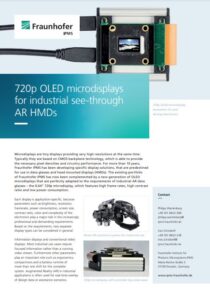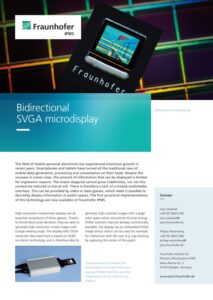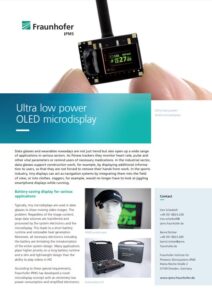
OLED microdisplays
720p OLED microdisplays for industrial see-through AR HMDs
Microdisplays are tiny displays providing very high resolutions at the same time. Typically they are based on CMOS backplane technology, which is able to provide the necessary pixel densities and circuitry performance. For more than 10 years, Fraunhofer IPMS has been developing specific display solutions, that are predestined for use in data glasses and head mounted displays (HMDs). The existing portfolio of Fraunhofer IPMS has now been complemented by a new generation of OLED microdisplays that are perfectly adapted to the requirements of industrial AR data glasses – the 0.64“ 720p microdisplay, which features high frame rates, high contrast ratio and low power consumption.
Each display is application-specific, because parameters such as brightness, resolution, framerate, power consumption, screen size, contrast ratio, color and complexity of the
electronics play a major role in the increasingly professional and demanding requirements. Based on the requirements, two separate display types can be considered in general:
Information displays and conventional video displays. Most industrial use cases require focused information rather than a running video stream. Furthermore other parameters play an important role such as ergonomics, compactness and a battery runtime of more than one shift for the complete system. Augmented Reality (AR) in industrial applications is often used for real-time overlay of design data or assistance scenarios.
Technical data
The new 720p OLED microdisplay provides a nominal resolution of 1280 × 720 pixels plus additional 10 pixels in each direction for display image adjustment, summing up in a total resolution of 1300 × 740 pixels. Based on a subpixel size of 5.5 μm × 5.5 μm and four sub-pixels, which are configured in a RGBW setup for the initial prototype, the nominal active area of 14.1 mm × 7.92 mm results in a screen diagonal of 0.64’’. Using a four sub-pixel arrangement also enables a monochrome version of that backplane with four times higher resolution, i.e. 2560 × 1440 pixels.The backplane already provides all necessary driver circuitry to operate the displays from a standard 24 Bit parallel RGB interface using well known synchronization signals vertical synchronization (VS), horizontal synchronization (HS) and data enable (DE).
Bidirectional SVGA microdisplay
The field of mobile personal electronics has experienced enormous growth in recent years. Smartphones and tablets have turned all the traditional laws of mobile data generation, processing and consumption on their head. Despite the increase in screen sizes, the amount of information that can be displayed is limited for ergonomic reasons. The screen diagonal cannot grow indefinitely, nor can the content be reduced in size at will. There is therefore a lack of a mobile multimedia interface. This can be provided by video or data glasses, which make it possible to discreetly display information in public spaces. The first pcractical implementations of this technology are now available at Fraunhofer IPMS.
High-resolution miniaturized displays are an essential component of these glasses. Thanks to tremendous pixel densities, they are able to generate high-resolution virtual images with a large viewing angle. The display with SVGA resolution described here is based on OLEDon-silicon technology, and is therefore able to generate high-contrast images with a large color space while consuming minimal energy. Unlike solutions that are already commercially available, the display has an embedded SVGA image sensor which can be used for example for interaction with the user (e.g. eye tracking by capturing the center of the pupil).
Technical description
A bidirectional display is able to both reproduce and record images. This is made possible by a special pixel arrangement. A pixel therefore not only comprises 4 subpixels for image rendering (RGBW) but also a photo diode for light detection. This structure results in a pixel matrix consisting of two submatrices: a display matrix with a nested image sensor matrix.
The bidirectional microdisplay described here has a resolution of 800 x 600 pixels (SVGA). The data is provided to the display via a 24 Bit (R, G, B, 8 Bit each) parallel interface. The value of the white pixel can either be determined through an internal calculation or provided externally via an additional 8 Bit channel. Data synchronization is realized by additional signals: VS (vertical sync), HS (horizontal sync) and DE (data enable). The grayscale camera output (8 Bit) is realized over a similar parallel interface.
The microdisplay chip also has a two-wire-interface (TWI) for configuration. This interface is used to adjust the brightness of the display, the camera exposure time and the time sequence control of the camera and display. The microdisplay supports both the time sequential and parallel operation of OLED emission and image sensor detection. A development system is available for evaluation to make it easier for users to adopt this new generation of bidirectional microdisplays. It allows to operate the microdisplay on a standard HDMI interface. The power supply and the image sensor data are provided over a standard USB3.0 interface.
Ultra low power OLED microdisplay
Data glasses and wearables nowadays are not just trend but also open up a wide range of applications in various sectors. As fitness trackers they monitor heart rate, pulse and other vital parameters or remind users of necessary medications. In the industrial sector, data glasses support construction work, for example, by displaying additional information to users, so that they are not forced to remove their hands from work. In the sports industry, tiny displays can act as navigation systems by integrating them into the field of view, or into clothes. Joggers, for example, would no longer have to look at jiggling smartphone displays while running.
Battery-saving display for various applications
Typically, tiny microdisplays are used in data glasses to show moving video images. The problem: Regardless of the image content, large data volumes are transferred and processed by the system electronics and the microdisplay. This leads to a short battery runtime and noticeable heat generation. Moreover, all necessary electronics including the battery are limitating the miniaturization of the entire system design. Many applications place higher priority on a long battery runtime and a slim and lightweight design than the ability to play videos in HD. According to these special requirements, Fraunhofer IPMS has developed a novel microdisplay concept with an extremely low power consumption and simplified electronics.


Deliverables
Contact Listings Owner Form
- Learn about who has visited this offer
- Get funding opportunities matching this technology
- Get detailed access statistics as listing owner






